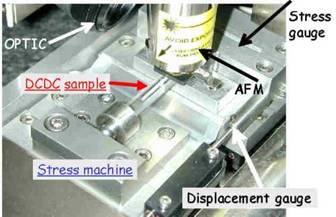Rechercher
Accueil > La Recherche > Axes & Equipes > Matière Molle & Verres > Equipe : Physique des Verres > Thème : Mécanismes d’endommagement des verres à l’échelle nanométrique
AFM investigation of stress-corrosion mechanisms
publié le , mis à jour le
Involved researchers : M. Ciccotti, M. George, A. Grimaldi, G. Pallares, F. Lechenault
The investigations on the slow crack propagation in silicate glasses are based on an original experimental setup combining an Atomic Force Microscope (AFM) and a loading setup which allows for very stable and slow crack propagation in a DCDC glass sample. The whole equipment is enclosed in a glove box containing a mixture of nitrogen ant vapour. By combining optical and atomic force microscopy we can monitor in real time (in-situ) the slow propagation of the crack tip for velocities between 10-5 m/s and 10-12 m/s. The focus of the investigation is the determination of the space and time scales of the corrosion mechanisms acting in the nanometric neighborhood of the crack tip, such as corrosion, leaching and plastic deformation.

Recent publication : J. Phys. D : Appl. Phys. 42, 214006 (2009)








